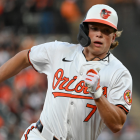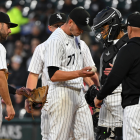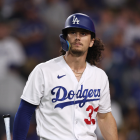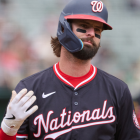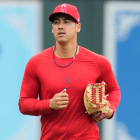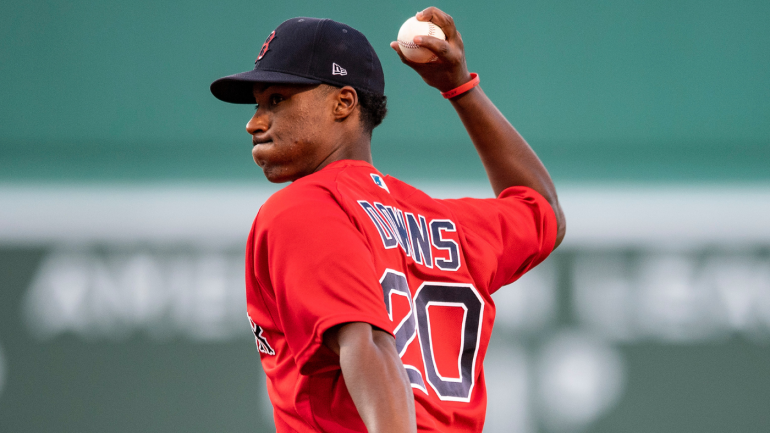
The arrival of the offseason means that it's time to rank stuff. Already this winter, we've sized up the 60 best free agents, both on an overall and positional basis. There's no law that prevents us from ranking minor-league players in addition to their big-league counterparts. As such, we're going to spend the winter evaluating every team's farm system.
The lack of a minor-league season makes that more of a challenge this year. It doesn't help that some teams opted against sharing video and data from their alternate-site camps with the rest of the league. As such, we've opted against overthinking this. Our rankings will essentially be the same as they were last winter with a few changes. First, we'll exclude anyone who graduated by exhausting their rookie eligibility; second, we'll replace them with draftees or other worthy prospects; and third, and lastly, we'll present the information in a new format.
In every article in this series, you'll find a team's top five prospects as well as five others we felt like including, either because of their promise or some other reason. For those top five prospects, you'll find a quick summation of their pros (their saving grace, if one will) and their cons (their fault line), as well as beefier report and our attempt to peg their "likeliest outcome."
These rankings were compiled by talking to industry folks -- scouts, analysts, and other evaluators -- and include a touch of our own evaluative biases. Remember, that this is more of an art than a science, and that the write-ups matter more than the rankings themselves.
Now, let's get on to the top five prospects in the Boston Red Sox system.
1. Jeter Downs, 2B
Age (as of 4/1/2021): 22
Height/Weight: 5-foot-11, 195 pounds
Acquired: Part of the Mookie Betts trade (Dodgers)
Highest level: Double-A
Saving grace: On-base skills
Fault line: Lack of impact
Scouting report: You have to feel bad for Downs. He's been traded twice in as many years: first going from the Reds to the Dodgers as part of a seven-player swap, and then to the Red Sox in the Betts blockbuster. Through it all, he's remained a solid prospect. Downs' value stems from his offense. He has a quick swing and a disciplined approach that should enable him to hit for average and get on base at healthy clips. There's some juice in his bat, too, and he maximizes his slugging ability by lifting the ball at an absurd frequency; about a quarter of his batted balls in 2019 were grounders, per FanGraphs. On defense, he's expected to end up at the keystone, though it's possible the Red Sox continue to give him reps at shortstop to maintain his optionality. Downs isn't likely to be a star, but he should be a steady starter, and soon.
Likeliest outcome: Regular second baseman
2. Triston Casas, 1B
Age (as of 4/1/2021): 21
Height/Weight: 6-foot-4, 238 pounds
Acquired: 26th overall pick in 2018 (American Heritage High School, Florida)
Highest level: High-A
Saving grace: Hitterish
Fault line: Not fielderish
Scouting report: While Casas attended the same high school as Eric Hosmer, the vertical nature of his swing has more in common with a different veteran first baseman, in Freddie Freeman. Aesthetics don't count for much on the scoreboard or on the statsheet, but the good news for the Red Sox is that Casas has all the necessary traits to mature into a middle-of-the-order hitter. That means the eye, the bat speed, the strength, and so on. What he doesn't have is many pro reps, or much of a fallback plan should his bat fall short. That's just how life goes for first basemen.
Likeliest outcome: Everyday first baseman
3. Bobby Dalbec, 1B/3B
Age (as of 4/1/2021): 25
Height/Weight: 6-foot-4, 227 pounds
Acquired: Fourth-round pick in 2016 (University of Arizona)
Highest level: MLB
Saving grace: Massive raw power
Fault line: Massive contact issues
Scouting report: Dalbec was promoted to the majors after the Red Sox sent Mitch Moreland to the Padres during the 2020 season. Although he's historically been a third baseman -- and a solid one with a cannon arm, at that -- he spent most of his big-league stint at the cold corner out of deference to Rafael Devers. Wherever Dalbec plays, the key to his long-term employment is his bat. He has big-time raw power that allows him to leave the park even when he doesn't make proper contact, but he's also prone to swinging-and-missing at obscene levels. His performances in the upper-minors suggest he should walk and bop enough to make it work, at least for a few years' time.
Likeliest outcome: Streaky regular at either corner-infield position
4. Connor Seabold, RHP
Age (as of 4/1/2021): 25
Height/Weight: 6-foot-2, 190 pounds
Acquired: Part of the Brandon Workman, Heath Hembree trade (Phillies)
Highest level: Double-A
Saving grace: Polish
Fault line: Outpitch
Scouting report: There ought to be a name for the stock boost players receive whenever they're acquired by a Chaim Bloom-managed team. Maybe we can call it the Seabold Effect? In a moment's notice, he morphed from being an obscure prospect with the Phillies to being the key of a notable deadline deal for the Red Sox. To be fair, some analytical front offices were already high on his game, ranking him as a top-five prospect in the Phillies system. He has a rising fastball that grades well on the Trackman, and he has improved his changeup enough to have a pair of average or better secondaries. Seabold's command is such that evaluators are hopeful he can outperform the sum of his parts. Provided he can stay healthy, he ought to get a look in 2021.
Likeliest outcome: No. 4 starter
5. Bryan Mata, RHP
Age (as of 4/1/2021): 21
Height/Weight: 6-foot-3, 240 pounds
Acquired: Amateur international free agent signing
Highest level: Double-A
Saving grace: Starter's arsenal
Fault line: Reliever's command
Scouting report: Mata's profile is in conflict. He has the physical frame and wide arsenal that would seem well-suited to soaking up innings at the back of a rotation. Yet he also has a top-heavy delivery and a low arm slot that gives left-handed hitters an edge -- to the extent that in 2019 they had an OPS against him that was .160 OPS points higher than what right-handers managed. Mata won't turn 22 until May, so the Red Sox have every reason to keep trotting him out there as a starter. Realistically, though, his future could come in a bulk or multi-inning relief capacity.
Likeliest outcome: Hybrid pitcher
Five others to know
Tanner Houck, RHP
Houck's delivery is a mirrored version of Chris Sale's, right down to the way his elbow creeps above his shoulder during his arm circle. The rest of Houck's game doesn't compare to Sale's, of course. He has below-average command and his lacking changeup permitted left-handed hitters to bat .283/.383/.363 against him in 2019. Houck's fastball-slider combination ought to play up in relief, which is where he spent most of his time in Triple-A. He's already debuted, so there's nothing stopping him from being a member of the Red Sox roster heading forward.Jarren Duran, OF
Duran appeared to be a candidate all year to make his big-league debut, but the call never came -- not even after Boston shipped veteran Kevin Pillar to the Rockies at the trade deadline. The Red Sox instead left Duran at the alternate site to work on his game. That was probably the right call. He has well-above-average speed and he had produced good results with a groundball-happy approach in the lower minors. The only thing he hit in Double-A was a wall, however, and it's unlikely that he would've fared well against big-league pitching. Another season in the minors, with another reworked swing, should leave him ready for the Show.Matthew Lugo, SS
Lugo, the 69th pick in the 2019 draft by way of his uncle Carlos Beltran's academy in Puerto Rico, won't celebrate his 20th birthday until next May. He has ample time, then, to make the most of a tool box that could include five average or better elements. Lugo has a simple yet effective swing at the dish, as well as the requisite athleticism and arm strength to stick at shortstop. He'll need to work on his approach in order to maximize his offensive upside, the way most teenagers do, but there's enough here to envision him becoming at least a reserve.Hudson Potts, 3B
The Red Sox were open for business at the deadline, with their moves introducing (among others) Seabold, Potts, and Jeisson Rosario to the organization. (Rosario, otherwise uncovered here, is a legit center fielder with offensive concerns.) Potts possesses well-above-average raw power and has seen action at the keystone in addition to his work at the hot corner. He needs to improve his contact rate (30 percent strikeouts in Double-A) if he's going to last in the ShowNick Yorke, 2B
Boston's decision to pop Yorke at No. 17 in the 2020 MLB Draft registered as the biggest surprise of the first round. One scout compared him to Justin Foscue, who went off the board earlier in the first round to the Rangers. The difference is that Foscue's bat had been vetted by Southeastern Conference pitching over the preceding three years, whereas Yorke is coming straight from high school. Should that comparison prove true, a fully realized Yorke will be a bat-first second baseman.














